Architecture Design/Research Project
VerifiedAdded on 2023/06/13
|8
|1636
|424
AI Summary
This project is about the design of a learning/exhibition center on a site located near Museum and Art Gallery of the Northern Territory in Darwin, Australia. The design of this learning/exhibition center will offer learners a platform to have a practical shape of the theoretical knowledge they have acquired in the various fields depending on the nature and practicality of such knowledge. Read more on Desklib.
Contribute Materials
Your contribution can guide someone’s learning journey. Share your
documents today.
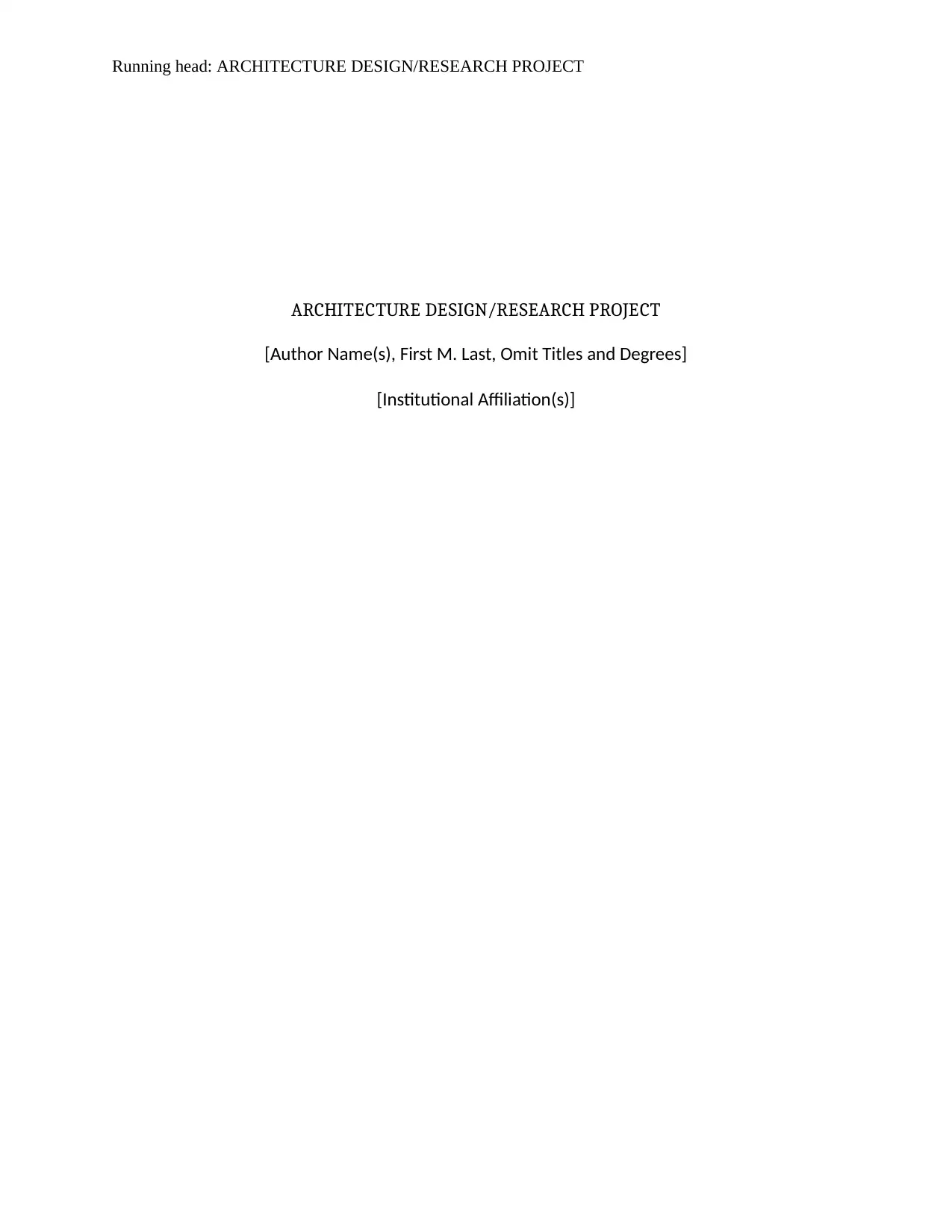
Running head: ARCHITECTURE DESIGN/RESEARCH PROJECT
ARCHITECTURE DESIGN/RESEARCH PROJECT
[Author Name(s), First M. Last, Omit Titles and Degrees]
[Institutional Affiliation(s)]
ARCHITECTURE DESIGN/RESEARCH PROJECT
[Author Name(s), First M. Last, Omit Titles and Degrees]
[Institutional Affiliation(s)]
Secure Best Marks with AI Grader
Need help grading? Try our AI Grader for instant feedback on your assignments.
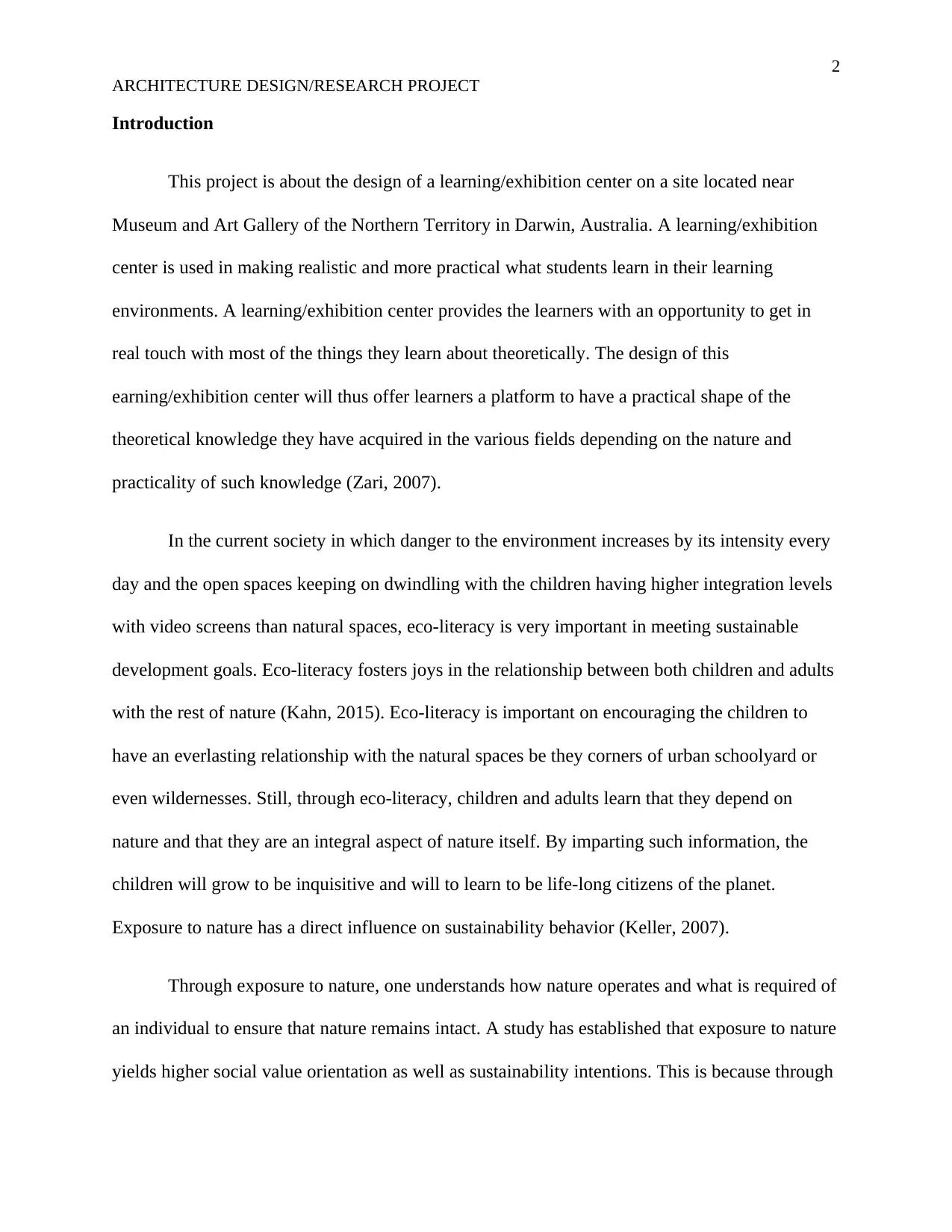
2
ARCHITECTURE DESIGN/RESEARCH PROJECT
Introduction
This project is about the design of a learning/exhibition center on a site located near
Museum and Art Gallery of the Northern Territory in Darwin, Australia. A learning/exhibition
center is used in making realistic and more practical what students learn in their learning
environments. A learning/exhibition center provides the learners with an opportunity to get in
real touch with most of the things they learn about theoretically. The design of this
earning/exhibition center will thus offer learners a platform to have a practical shape of the
theoretical knowledge they have acquired in the various fields depending on the nature and
practicality of such knowledge (Zari, 2007).
In the current society in which danger to the environment increases by its intensity every
day and the open spaces keeping on dwindling with the children having higher integration levels
with video screens than natural spaces, eco-literacy is very important in meeting sustainable
development goals. Eco-literacy fosters joys in the relationship between both children and adults
with the rest of nature (Kahn, 2015). Eco-literacy is important on encouraging the children to
have an everlasting relationship with the natural spaces be they corners of urban schoolyard or
even wildernesses. Still, through eco-literacy, children and adults learn that they depend on
nature and that they are an integral aspect of nature itself. By imparting such information, the
children will grow to be inquisitive and will to learn to be life-long citizens of the planet.
Exposure to nature has a direct influence on sustainability behavior (Keller, 2007).
Through exposure to nature, one understands how nature operates and what is required of
an individual to ensure that nature remains intact. A study has established that exposure to nature
yields higher social value orientation as well as sustainability intentions. This is because through
ARCHITECTURE DESIGN/RESEARCH PROJECT
Introduction
This project is about the design of a learning/exhibition center on a site located near
Museum and Art Gallery of the Northern Territory in Darwin, Australia. A learning/exhibition
center is used in making realistic and more practical what students learn in their learning
environments. A learning/exhibition center provides the learners with an opportunity to get in
real touch with most of the things they learn about theoretically. The design of this
earning/exhibition center will thus offer learners a platform to have a practical shape of the
theoretical knowledge they have acquired in the various fields depending on the nature and
practicality of such knowledge (Zari, 2007).
In the current society in which danger to the environment increases by its intensity every
day and the open spaces keeping on dwindling with the children having higher integration levels
with video screens than natural spaces, eco-literacy is very important in meeting sustainable
development goals. Eco-literacy fosters joys in the relationship between both children and adults
with the rest of nature (Kahn, 2015). Eco-literacy is important on encouraging the children to
have an everlasting relationship with the natural spaces be they corners of urban schoolyard or
even wildernesses. Still, through eco-literacy, children and adults learn that they depend on
nature and that they are an integral aspect of nature itself. By imparting such information, the
children will grow to be inquisitive and will to learn to be life-long citizens of the planet.
Exposure to nature has a direct influence on sustainability behavior (Keller, 2007).
Through exposure to nature, one understands how nature operates and what is required of
an individual to ensure that nature remains intact. A study has established that exposure to nature
yields higher social value orientation as well as sustainability intentions. This is because through
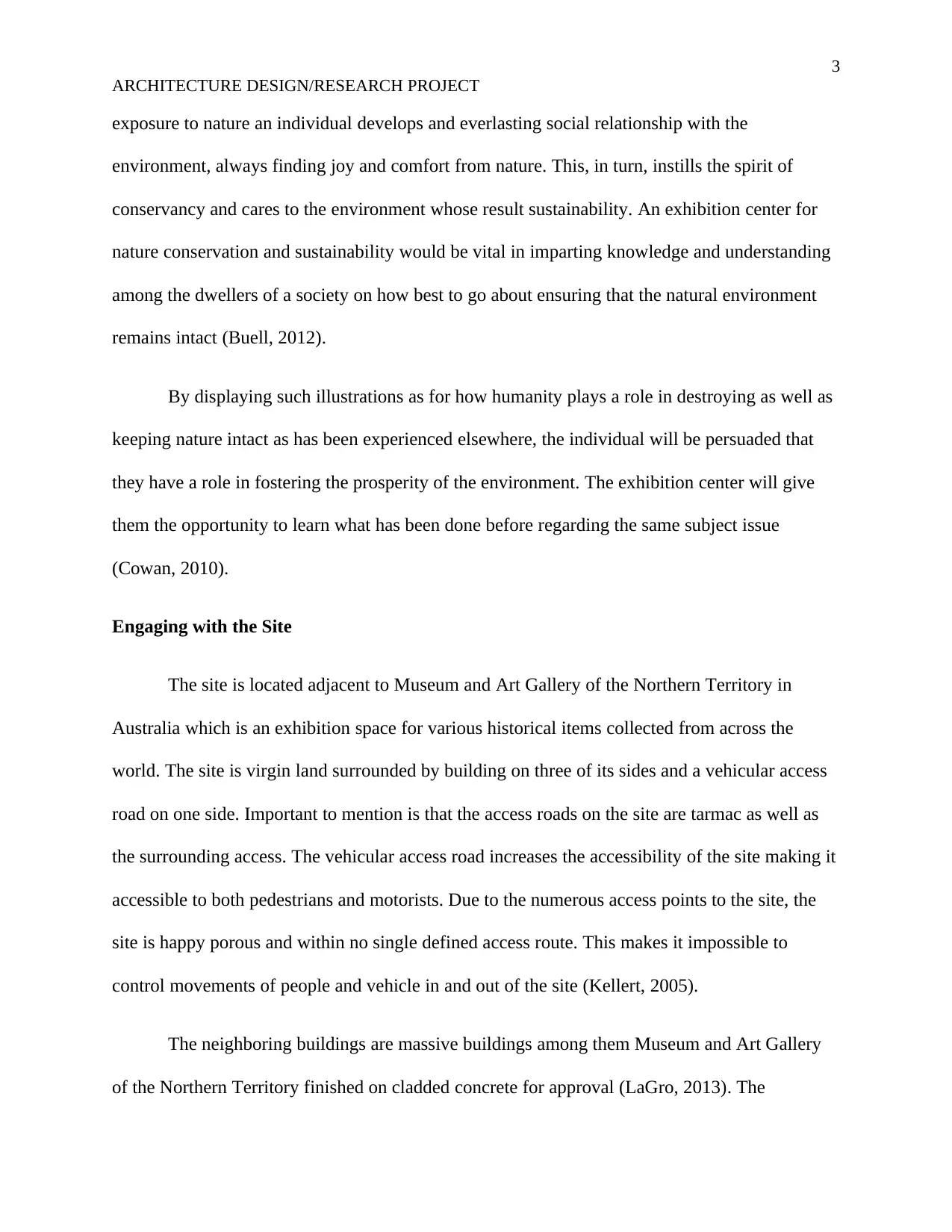
3
ARCHITECTURE DESIGN/RESEARCH PROJECT
exposure to nature an individual develops and everlasting social relationship with the
environment, always finding joy and comfort from nature. This, in turn, instills the spirit of
conservancy and cares to the environment whose result sustainability. An exhibition center for
nature conservation and sustainability would be vital in imparting knowledge and understanding
among the dwellers of a society on how best to go about ensuring that the natural environment
remains intact (Buell, 2012).
By displaying such illustrations as for how humanity plays a role in destroying as well as
keeping nature intact as has been experienced elsewhere, the individual will be persuaded that
they have a role in fostering the prosperity of the environment. The exhibition center will give
them the opportunity to learn what has been done before regarding the same subject issue
(Cowan, 2010).
Engaging with the Site
The site is located adjacent to Museum and Art Gallery of the Northern Territory in
Australia which is an exhibition space for various historical items collected from across the
world. The site is virgin land surrounded by building on three of its sides and a vehicular access
road on one side. Important to mention is that the access roads on the site are tarmac as well as
the surrounding access. The vehicular access road increases the accessibility of the site making it
accessible to both pedestrians and motorists. Due to the numerous access points to the site, the
site is happy porous and within no single defined access route. This makes it impossible to
control movements of people and vehicle in and out of the site (Kellert, 2005).
The neighboring buildings are massive buildings among them Museum and Art Gallery
of the Northern Territory finished on cladded concrete for approval (LaGro, 2013). The
ARCHITECTURE DESIGN/RESEARCH PROJECT
exposure to nature an individual develops and everlasting social relationship with the
environment, always finding joy and comfort from nature. This, in turn, instills the spirit of
conservancy and cares to the environment whose result sustainability. An exhibition center for
nature conservation and sustainability would be vital in imparting knowledge and understanding
among the dwellers of a society on how best to go about ensuring that the natural environment
remains intact (Buell, 2012).
By displaying such illustrations as for how humanity plays a role in destroying as well as
keeping nature intact as has been experienced elsewhere, the individual will be persuaded that
they have a role in fostering the prosperity of the environment. The exhibition center will give
them the opportunity to learn what has been done before regarding the same subject issue
(Cowan, 2010).
Engaging with the Site
The site is located adjacent to Museum and Art Gallery of the Northern Territory in
Australia which is an exhibition space for various historical items collected from across the
world. The site is virgin land surrounded by building on three of its sides and a vehicular access
road on one side. Important to mention is that the access roads on the site are tarmac as well as
the surrounding access. The vehicular access road increases the accessibility of the site making it
accessible to both pedestrians and motorists. Due to the numerous access points to the site, the
site is happy porous and within no single defined access route. This makes it impossible to
control movements of people and vehicle in and out of the site (Kellert, 2005).
The neighboring buildings are massive buildings among them Museum and Art Gallery
of the Northern Territory finished on cladded concrete for approval (LaGro, 2013). The
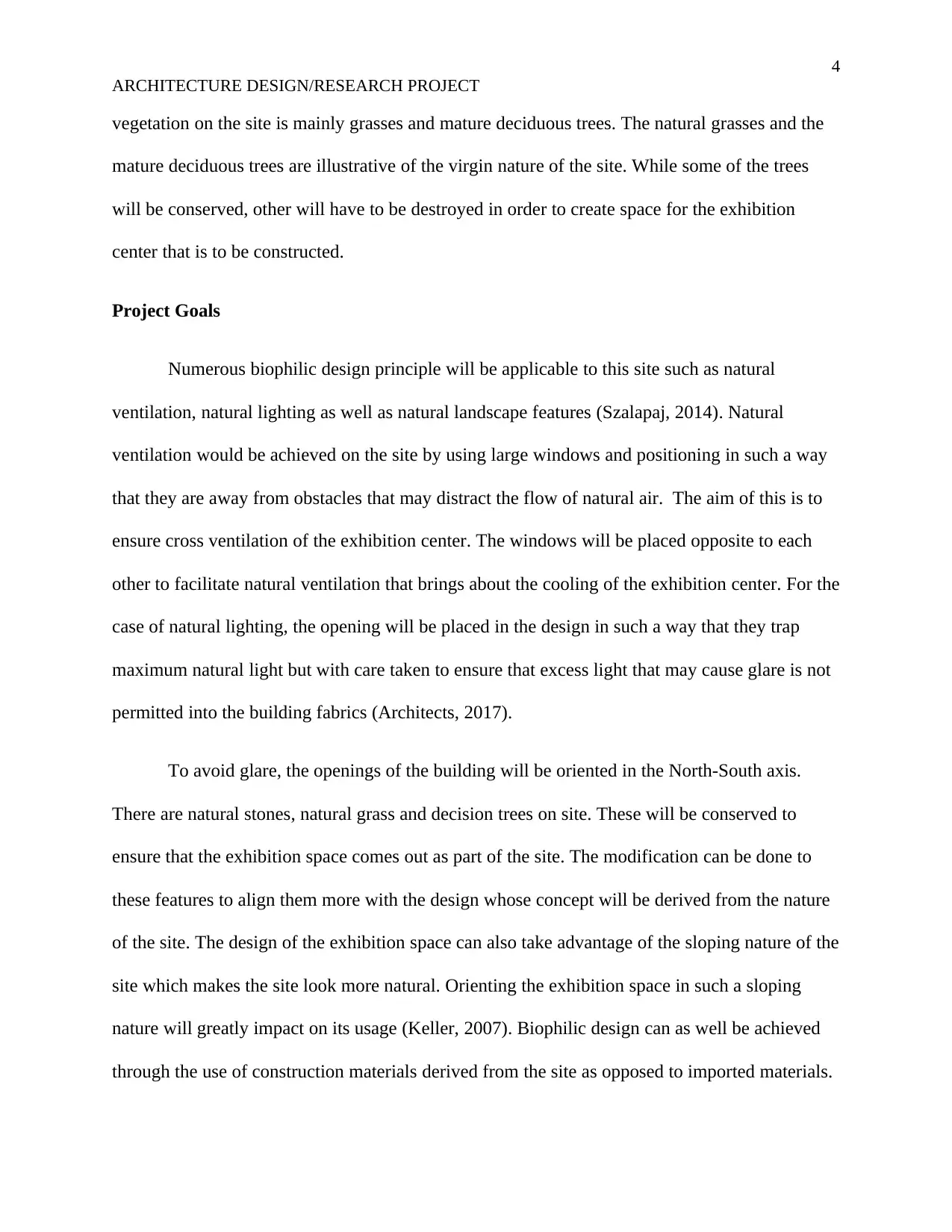
4
ARCHITECTURE DESIGN/RESEARCH PROJECT
vegetation on the site is mainly grasses and mature deciduous trees. The natural grasses and the
mature deciduous trees are illustrative of the virgin nature of the site. While some of the trees
will be conserved, other will have to be destroyed in order to create space for the exhibition
center that is to be constructed.
Project Goals
Numerous biophilic design principle will be applicable to this site such as natural
ventilation, natural lighting as well as natural landscape features (Szalapaj, 2014). Natural
ventilation would be achieved on the site by using large windows and positioning in such a way
that they are away from obstacles that may distract the flow of natural air. The aim of this is to
ensure cross ventilation of the exhibition center. The windows will be placed opposite to each
other to facilitate natural ventilation that brings about the cooling of the exhibition center. For the
case of natural lighting, the opening will be placed in the design in such a way that they trap
maximum natural light but with care taken to ensure that excess light that may cause glare is not
permitted into the building fabrics (Architects, 2017).
To avoid glare, the openings of the building will be oriented in the North-South axis.
There are natural stones, natural grass and decision trees on site. These will be conserved to
ensure that the exhibition space comes out as part of the site. The modification can be done to
these features to align them more with the design whose concept will be derived from the nature
of the site. The design of the exhibition space can also take advantage of the sloping nature of the
site which makes the site look more natural. Orienting the exhibition space in such a sloping
nature will greatly impact on its usage (Keller, 2007). Biophilic design can as well be achieved
through the use of construction materials derived from the site as opposed to imported materials.
ARCHITECTURE DESIGN/RESEARCH PROJECT
vegetation on the site is mainly grasses and mature deciduous trees. The natural grasses and the
mature deciduous trees are illustrative of the virgin nature of the site. While some of the trees
will be conserved, other will have to be destroyed in order to create space for the exhibition
center that is to be constructed.
Project Goals
Numerous biophilic design principle will be applicable to this site such as natural
ventilation, natural lighting as well as natural landscape features (Szalapaj, 2014). Natural
ventilation would be achieved on the site by using large windows and positioning in such a way
that they are away from obstacles that may distract the flow of natural air. The aim of this is to
ensure cross ventilation of the exhibition center. The windows will be placed opposite to each
other to facilitate natural ventilation that brings about the cooling of the exhibition center. For the
case of natural lighting, the opening will be placed in the design in such a way that they trap
maximum natural light but with care taken to ensure that excess light that may cause glare is not
permitted into the building fabrics (Architects, 2017).
To avoid glare, the openings of the building will be oriented in the North-South axis.
There are natural stones, natural grass and decision trees on site. These will be conserved to
ensure that the exhibition space comes out as part of the site. The modification can be done to
these features to align them more with the design whose concept will be derived from the nature
of the site. The design of the exhibition space can also take advantage of the sloping nature of the
site which makes the site look more natural. Orienting the exhibition space in such a sloping
nature will greatly impact on its usage (Keller, 2007). Biophilic design can as well be achieved
through the use of construction materials derived from the site as opposed to imported materials.
Secure Best Marks with AI Grader
Need help grading? Try our AI Grader for instant feedback on your assignments.
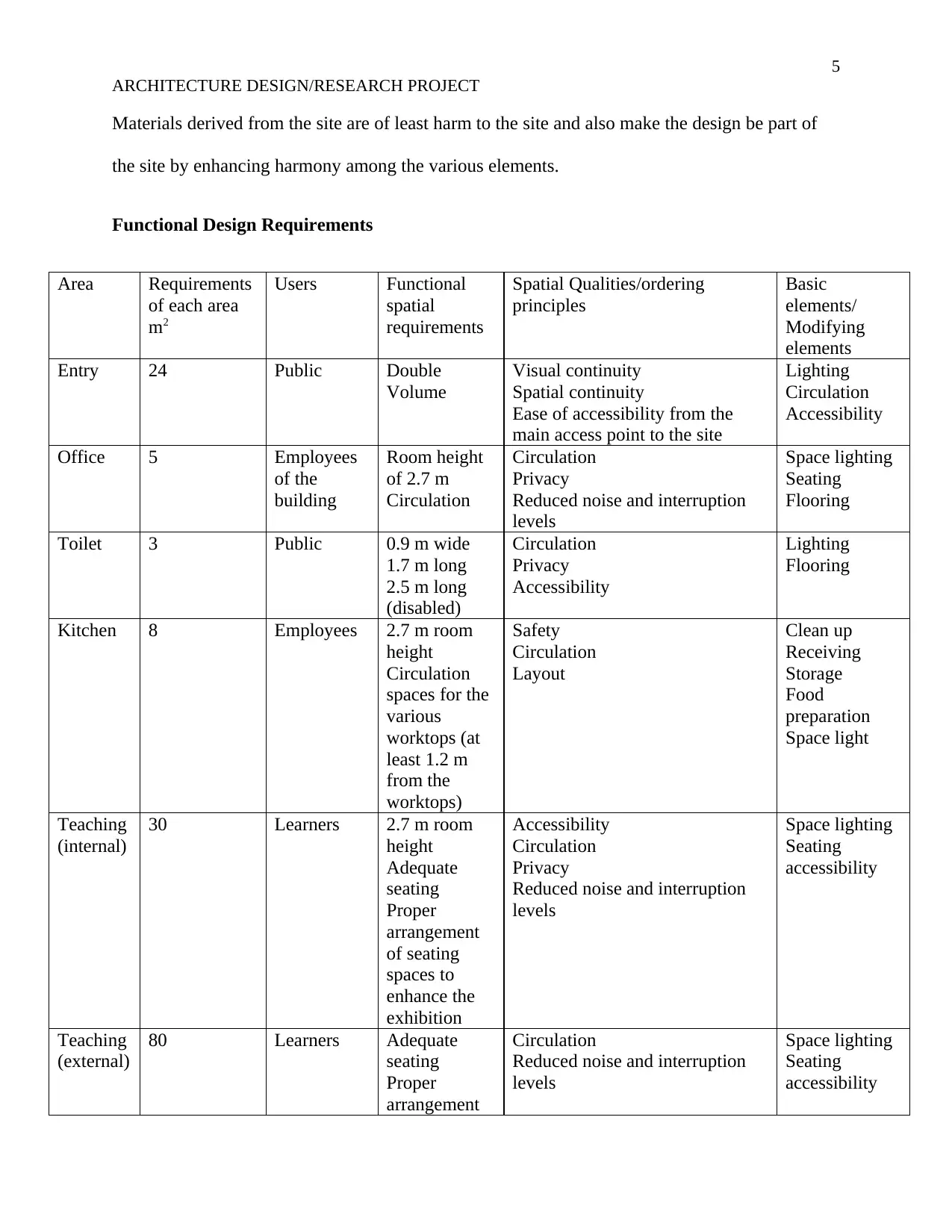
5
ARCHITECTURE DESIGN/RESEARCH PROJECT
Materials derived from the site are of least harm to the site and also make the design be part of
the site by enhancing harmony among the various elements.
Functional Design Requirements
Area Requirements
of each area
m2
Users Functional
spatial
requirements
Spatial Qualities/ordering
principles
Basic
elements/
Modifying
elements
Entry 24 Public Double
Volume
Visual continuity
Spatial continuity
Ease of accessibility from the
main access point to the site
Lighting
Circulation
Accessibility
Office 5 Employees
of the
building
Room height
of 2.7 m
Circulation
Circulation
Privacy
Reduced noise and interruption
levels
Space lighting
Seating
Flooring
Toilet 3 Public 0.9 m wide
1.7 m long
2.5 m long
(disabled)
Circulation
Privacy
Accessibility
Lighting
Flooring
Kitchen 8 Employees 2.7 m room
height
Circulation
spaces for the
various
worktops (at
least 1.2 m
from the
worktops)
Safety
Circulation
Layout
Clean up
Receiving
Storage
Food
preparation
Space light
Teaching
(internal)
30 Learners 2.7 m room
height
Adequate
seating
Proper
arrangement
of seating
spaces to
enhance the
exhibition
Accessibility
Circulation
Privacy
Reduced noise and interruption
levels
Space lighting
Seating
accessibility
Teaching
(external)
80 Learners Adequate
seating
Proper
arrangement
Circulation
Reduced noise and interruption
levels
Space lighting
Seating
accessibility
ARCHITECTURE DESIGN/RESEARCH PROJECT
Materials derived from the site are of least harm to the site and also make the design be part of
the site by enhancing harmony among the various elements.
Functional Design Requirements
Area Requirements
of each area
m2
Users Functional
spatial
requirements
Spatial Qualities/ordering
principles
Basic
elements/
Modifying
elements
Entry 24 Public Double
Volume
Visual continuity
Spatial continuity
Ease of accessibility from the
main access point to the site
Lighting
Circulation
Accessibility
Office 5 Employees
of the
building
Room height
of 2.7 m
Circulation
Circulation
Privacy
Reduced noise and interruption
levels
Space lighting
Seating
Flooring
Toilet 3 Public 0.9 m wide
1.7 m long
2.5 m long
(disabled)
Circulation
Privacy
Accessibility
Lighting
Flooring
Kitchen 8 Employees 2.7 m room
height
Circulation
spaces for the
various
worktops (at
least 1.2 m
from the
worktops)
Safety
Circulation
Layout
Clean up
Receiving
Storage
Food
preparation
Space light
Teaching
(internal)
30 Learners 2.7 m room
height
Adequate
seating
Proper
arrangement
of seating
spaces to
enhance the
exhibition
Accessibility
Circulation
Privacy
Reduced noise and interruption
levels
Space lighting
Seating
accessibility
Teaching
(external)
80 Learners Adequate
seating
Proper
arrangement
Circulation
Reduced noise and interruption
levels
Space lighting
Seating
accessibility
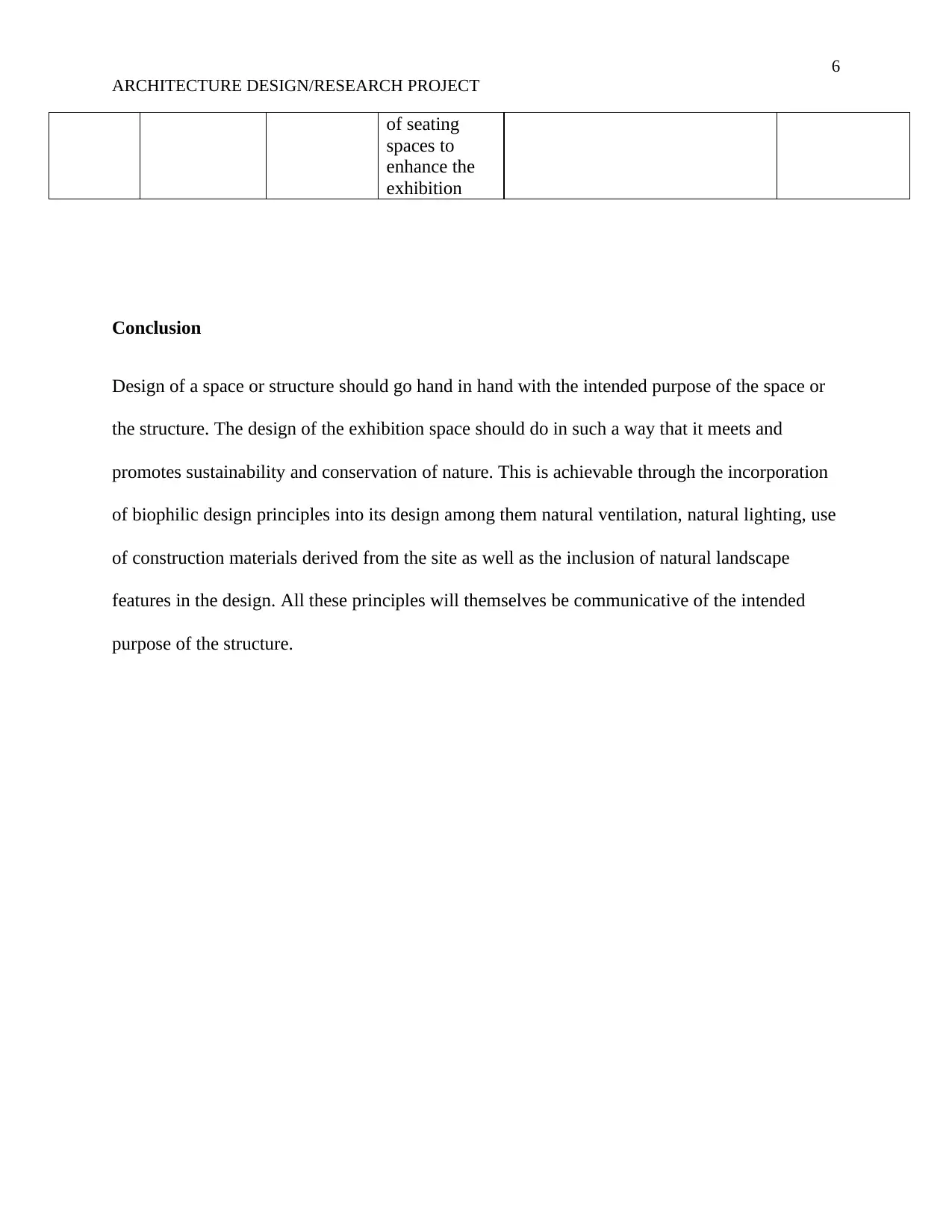
6
ARCHITECTURE DESIGN/RESEARCH PROJECT
of seating
spaces to
enhance the
exhibition
Conclusion
Design of a space or structure should go hand in hand with the intended purpose of the space or
the structure. The design of the exhibition space should do in such a way that it meets and
promotes sustainability and conservation of nature. This is achievable through the incorporation
of biophilic design principles into its design among them natural ventilation, natural lighting, use
of construction materials derived from the site as well as the inclusion of natural landscape
features in the design. All these principles will themselves be communicative of the intended
purpose of the structure.
ARCHITECTURE DESIGN/RESEARCH PROJECT
of seating
spaces to
enhance the
exhibition
Conclusion
Design of a space or structure should go hand in hand with the intended purpose of the space or
the structure. The design of the exhibition space should do in such a way that it meets and
promotes sustainability and conservation of nature. This is achievable through the incorporation
of biophilic design principles into its design among them natural ventilation, natural lighting, use
of construction materials derived from the site as well as the inclusion of natural landscape
features in the design. All these principles will themselves be communicative of the intended
purpose of the structure.

7
ARCHITECTURE DESIGN/RESEARCH PROJECT
References
Anderson, J. R. (2016). Innovations in Landscape Architecture. London: Routledge.
Architects, A. I. (2017). The Architecture Student's Handbook of Professional Practice. New
York: John Wiley & Sons.
Buell, S. R. (2012). Sensing Site: Expanding Site Analysis with Conditions of Experience and
Time. Carolina: University of North Carolina at Charlotte.
Cowan, S. &. (2010). Ecological design. New York: IGI Global.
Hepler, D. (2012). Drafting and Design for Architecture & Construction. London: Cengage
Learning.
Kahn, A. (2015). Site Matters: Design Concepts, Histories, and Strategies. New York:
Psychology Press.
Keller, S. R. (2007). Biophilic Design: The Theory, Science and Practice of Bringing Buildings
to Life. Washington DC: John Wiley & Sons.
Kellert, S. R. (2005). Building for life: Designing and understanding the human-nature
connection. Washington DC: Island Press.
LaGro, J. A. (2013). Site Analysis: Informing Context-Sensitive and Sustainable Site Planning
and Design. New York: John Wiley & Sons.
Szalapaj, P. (2014). Contemporary Architecture and the Digital Design Process. New Delhi:
Routledge.
ARCHITECTURE DESIGN/RESEARCH PROJECT
References
Anderson, J. R. (2016). Innovations in Landscape Architecture. London: Routledge.
Architects, A. I. (2017). The Architecture Student's Handbook of Professional Practice. New
York: John Wiley & Sons.
Buell, S. R. (2012). Sensing Site: Expanding Site Analysis with Conditions of Experience and
Time. Carolina: University of North Carolina at Charlotte.
Cowan, S. &. (2010). Ecological design. New York: IGI Global.
Hepler, D. (2012). Drafting and Design for Architecture & Construction. London: Cengage
Learning.
Kahn, A. (2015). Site Matters: Design Concepts, Histories, and Strategies. New York:
Psychology Press.
Keller, S. R. (2007). Biophilic Design: The Theory, Science and Practice of Bringing Buildings
to Life. Washington DC: John Wiley & Sons.
Kellert, S. R. (2005). Building for life: Designing and understanding the human-nature
connection. Washington DC: Island Press.
LaGro, J. A. (2013). Site Analysis: Informing Context-Sensitive and Sustainable Site Planning
and Design. New York: John Wiley & Sons.
Szalapaj, P. (2014). Contemporary Architecture and the Digital Design Process. New Delhi:
Routledge.
Paraphrase This Document
Need a fresh take? Get an instant paraphrase of this document with our AI Paraphraser

8
ARCHITECTURE DESIGN/RESEARCH PROJECT
Zari, M. P. (2007). BIOMIMETIC APPROACHES TO ARCHITECTURAL DESIGN FOR
INCREASED SUSTAINABILITY. Wellington: Springer.
ARCHITECTURE DESIGN/RESEARCH PROJECT
Zari, M. P. (2007). BIOMIMETIC APPROACHES TO ARCHITECTURAL DESIGN FOR
INCREASED SUSTAINABILITY. Wellington: Springer.
1 out of 8
Your All-in-One AI-Powered Toolkit for Academic Success.
+13062052269
info@desklib.com
Available 24*7 on WhatsApp / Email
![[object Object]](/_next/static/media/star-bottom.7253800d.svg)
Unlock your academic potential
© 2024 | Zucol Services PVT LTD | All rights reserved.